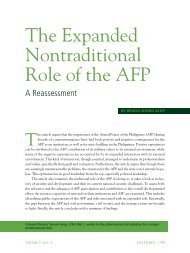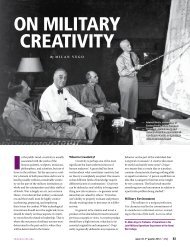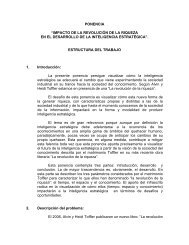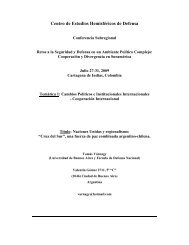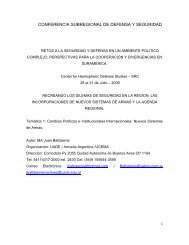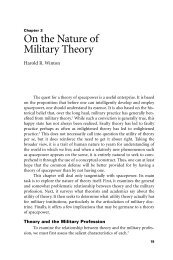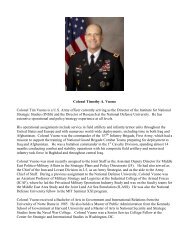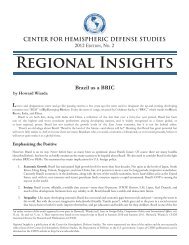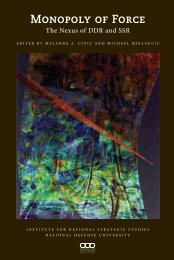In the second half of the 20th century, the US enjoyed pre-eminence ...
In the second half of the 20th century, the US enjoyed pre-eminence ...
In the second half of the 20th century, the US enjoyed pre-eminence ...
You also want an ePaper? Increase the reach of your titles
YUMPU automatically turns print PDFs into web optimized ePapers that Google loves.
(through contract, past association, etc.) in some way with DOD. Layer 4 consists <strong>of</strong> <strong>the</strong> in-house<br />
S&Es who are DOD employees funded by S&T dollars. Strictly speaking, Layers 3 and 4 are<br />
also members <strong>of</strong> Layer 2, which itself is a member <strong>of</strong> Layer 1. The number <strong>of</strong> in-house DOD<br />
S&Ts and <strong>the</strong> nongovernment S&Ts bonded to DOD generally track <strong>the</strong> size <strong>of</strong> <strong>the</strong> DOD<br />
program. Because <strong>the</strong> DOD program, on average, has been constant for decades, we assume this<br />
will continue. We have, <strong>the</strong>refore, kept <strong>the</strong> size <strong>of</strong> Layers 3 and 4 at <strong>the</strong> <strong>pre</strong>sent values. One<br />
could add many additional components (e.g., S&Es <strong>of</strong> Allies), but for conceptual purposes <strong>the</strong><br />
four layers should suffice.<br />
Total DOD S&T Workforce<br />
<strong>US</strong> S&Es doing S&T (est ~ 2M)<br />
DOD inhouse S&T Workforce<br />
(est ~ 15K in 2050)<br />
“Bonded” extramural researchers<br />
(est ~ 15K in 2050)<br />
Global Population <strong>of</strong> S&Es doing S&T in 2050 (authors’ estimate ~ 10M)<br />
Figure 6. Visualization <strong>of</strong> Global S&T Workforce in Layers for 2050 According to Authors’<br />
Estimates <strong>of</strong> Population in <strong>the</strong> Four Components or Layers<br />
This visualization makes <strong>the</strong> challenges quite apparent. First, <strong>the</strong> number <strong>of</strong> members in each<br />
layer decreases dramatically from Layer 1 to Layer 4, as indicated by <strong>the</strong> area <strong>of</strong> each layer<br />
(about 10 million globally in Layer 1 to about 15,000 in DOD in Layer 4). Clearly, our largest<br />
window on <strong>the</strong> world <strong>of</strong> global S&T is our national S&T workforce. This workforce, however,<br />
spends most <strong>of</strong> its time not thinking about national defense. Gaining access to defense-relevant<br />
knowledge resident in <strong>the</strong> U.S. national S&T workforce will be a significant challenge for DOD.<br />
It is instructive to briefly compare <strong>the</strong> situation depicted in Figure 6 to <strong>the</strong> era when <strong>the</strong> United<br />
States dominated <strong>the</strong> global S&T enterprise. <strong>In</strong> this era, <strong>the</strong> United States was about one-<strong>half</strong> <strong>of</strong><br />
Layer 1 and <strong>the</strong> DOD in-house S&T workforce was about one-tenth <strong>of</strong> <strong>the</strong> U.S. S&T workforce.<br />
<strong>In</strong> that era, a single DOD federal S&T worker was, on average, outnumbered globally about<br />
20:1. By 2050, that ratio will have increased to about 800:1. The numerical consequences are<br />
clear. <strong>In</strong> <strong>the</strong> future, each DOD S&E will have significantly more colleagues to track globally and<br />
domestically to maintain awareness <strong>of</strong> S&T developments. This scenario has major implications<br />
in regard to <strong>the</strong> DOD S&T workforce. It certainly suggests that <strong>the</strong> quality <strong>of</strong> each DOD federal<br />
S&E must be high and that efforts must be undertaken to improve connectivity between <strong>the</strong><br />
DOD S&T workforce and national S&T workforce.<br />
17



